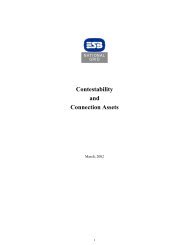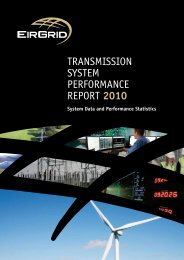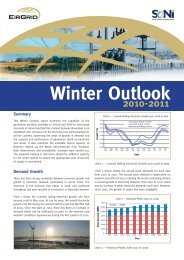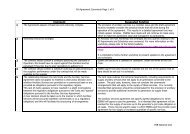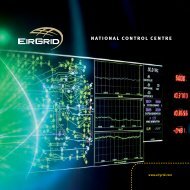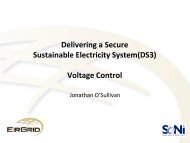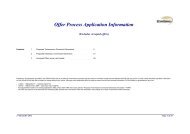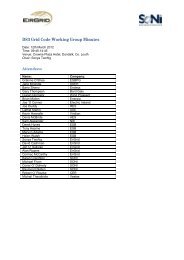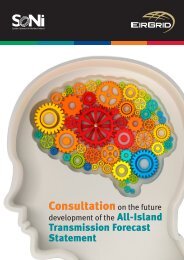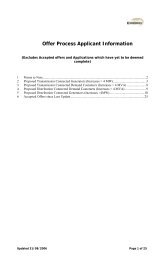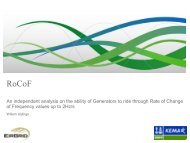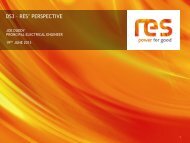DS3 RoCoF - Eirgrid
DS3 RoCoF - Eirgrid
DS3 RoCoF - Eirgrid
You also want an ePaper? Increase the reach of your titles
YUMPU automatically turns print PDFs into web optimized ePapers that Google loves.
<strong>DS3</strong>:<br />
Rate of Change of Frequency (ROCOF)<br />
Workstream<br />
EirGrid and SONI, 2011 Page 1
BACKGROUND<br />
Rate of Change of Frequency and the investigation of same is one workstream within the <strong>DS3</strong><br />
programme. This, together with the other workstreams provides an integrated solution in terms of<br />
the operational integration of renewables.<br />
The “Facilitation of Renewables” report indicated that the key limit to allowing high real time<br />
penetrations of wind power plants on the system was the rate of change of frequency (ROCOF).<br />
Specifically, the studies identified that with increasing wind power plant the synchronous on-line<br />
inertia on the system would reduce. The “Ensuring a Secure, Sustainable Electricity system” report<br />
indicated that this would on average reduce by 25% with an assumed portfolio consistent with the<br />
renewable policy objectives. This reduced inertia will result in higher ROCOF being experienced for<br />
the loss of a single large generation unit.<br />
The current Grid Code in Ireland only requires generators to be able to ride through ROCOF of 0.5<br />
Hz/s. It is not currently clear what standard is required of each distribution generator in Northern<br />
Ireland (NI) but it is understood to be in the range of 0.25 to 0.4 Hz/s. From the year 2000 onwards,<br />
all transmission connected conventional generation in NI should as part of their connection<br />
agreement meet a Minimal Functional Specification ROCOF requirement of 1.5Hz/s From<br />
operational experience and analysis, ROCOF in excess of 0.5 Hz/s are likely to be encountered when<br />
the system exceeds a 50% system non-synchronous penetration (SNSP) level or the synchronous<br />
inertia falls below 25000 MW-seconds. In addition, the loss of mains protection utilised in the<br />
distribution network in Ireland and employ ROCOF in excess of 0.6 Hz/s. Operating a power system<br />
where a ROCOF of greater than 0.5 Hz/s is likely to occur for a probable event (loss of a single<br />
generator) and could lead to the cascade tripping of all remaining generation would not be prudent.<br />
Therefore, in order to securely operate a power system with high penetrations of wind power plant<br />
there needs to be a reliable level of performance from generators and any associated protection<br />
equipment, i.e. that the plant can securely operate with ROCOF well in excess of 0.5 Hz/s or that the<br />
inertia on the system with respect to the size of largest in feed remains high (in the order of 25000<br />
MW-seconds for the Ireland and Northern Ireland power system).<br />
The objective of this workstream is to ensure that an operational policy is developed which clearly<br />
understands the issues of ROCOF and seeks to systematically address the critical areas in order to be<br />
able to operate a power system with respect to ROCOF issues at up to 75% SNSP.<br />
EirGrid and SONI, 2011 Page 2
APPROACH<br />
There are different approaches that can be taken to the ROCOF issue, and the final solution is likely<br />
to be some combination of these approaches:<br />
Grid Code Approach which could include the following;<br />
a. All plant to ride-through ROCOF values greater than 0.5 Hz/second, based on discussion with<br />
equipment manufacturers and changes to the standards<br />
b. Develop new anti-islanding strategies including a review of the current settings on ROCOF relays<br />
System Services Approach which could include the following;<br />
a. Seek the provision of different forms of inertia, such as flywheels or synchronous compensators,<br />
so that high values of ROCOF are not reached<br />
b. Incentivise more flexible plant, such as CCGTs with low minimum loads, or conventional<br />
machines with de-clutching action so that they can switch easily to synchronous compensation<br />
mode<br />
c. Demand side management such as batteries or compressed air storage<br />
ROCOF<br />
Hz/s<br />
0.5<br />
Performance<br />
Monitoring<br />
High Wind Reports<br />
and Analysis<br />
Operational Tools<br />
Grid Code Changes<br />
and Clarifications<br />
Target<br />
ROCOF
SNSP<br />
75%<br />
Option 2 – Achieve higher<br />
allowable SNSP values<br />
through increased<br />
flexibility and/or use of<br />
alternative sources of<br />
inertia<br />
High Wind Reports and<br />
Analysis<br />
Performance Monitoring<br />
Incentivise de-clutching or<br />
Synchronous compensators<br />
Incentivise Machines with<br />
higher inertia values<br />
Incentivise CCGTs with<br />
lower minimums loads<br />
50%<br />
Review of System Service<br />
Payments<br />
Increasing Flexibility &<br />
Alternative Sources of Inertia<br />
SCOPE<br />
The scope of the ROCOF project plan will be broken into four areas of work. These are:<br />
Setting appropriate ROCOF standards on all generators (Transmission and Distribution<br />
Connected) and appropriate testing<br />
Ensuring appropriate anti islanding on distribution protection<br />
On-line tool development and modelling improvement<br />
Operational Policy review<br />
Setting appropriate ROCOF standards on all generators<br />
This work area will examine how clarified or enhanced standards will be developed and brought<br />
in to obligate all generators including wind power plants in Ireland and Northern Ireland,<br />
transmission and distribution connected. This will involve Grid and Distribution Code changes.<br />
In Northern Ireland, there will need to be an investigation of where these regulations are best<br />
placed including connection agreements, grid and distribution codes. The changes need to be<br />
driven by a detailed examination of individual plant items that could potentially trip during high<br />
values of ROCOF. This work will need co-ordination and co-operation between the TSOs, DSOs,<br />
conventional and wind generators, and equipment manufacturers. Initially, this will be through<br />
formal compliance statements from all generators to this effect. Over a period of time,<br />
performance monitoring data of actual events and testing of new and existing plant will<br />
augment these initial compliance statements from generators.<br />
Ensuring appropriate ROCOF on distribution protection<br />
The use of ROCOF for loss of mains protection will be examined with the DSOs in Ireland and<br />
Northern Ireland to ascertain if it is possible to increase the settings for the G10 and G59<br />
EirGrid and SONI, 2011 Page 4
protection without impacting on the quality of protection employed in the distribution system<br />
and which assists in operating a secure power system.<br />
On line tool development and modelling improvement<br />
This work area will leverage developments in real time domain simulations in the WSAT<br />
workstream and data collected via the Renewable Data workstream.<br />
In particular, two regular reports will be used, High Wind Event and Actual Event performance<br />
reports.<br />
A High Wind Event report will be produced on a six monthly basis and will simulate a range of<br />
contingencies, wind power transfers and disturbances with the time domain model of the<br />
system. This report will provide system operators with a review of potential issues with<br />
operating the system at consistently higher penetrations of wind.<br />
An Actual Event report will be produced every six months and will provide a review of large<br />
frequency disturbances events on the system against the modelled system. Sub groups for<br />
validation and cross validation of generator parameters will be determined. The output of this<br />
report will be recommendations for new parameters and model structures to be used in the real<br />
time system model used in the real time and for the development of high wind event report.<br />
A key dependency for this work stream is the development of representative models of all types<br />
of generators related to voltage control, frequency control, and fault ride through capability<br />
which will then be used to develop an all island WSAT model.<br />
Operational Policy review<br />
Operational policy review will be conducted every year. The inputs that will be required are the<br />
current status from each of the relevant work areas. Based on a review of the status of ROCOF<br />
capabilities of generators and distribution protection and the High wind event and Actual event<br />
reports a decision can be made on whether to adjust the operational policy on SNSP, inertia or<br />
some other relevant metric. It is likely that this adjustment will be provisional until at least the<br />
next formal review. The provisional policy will be formally adopted when there has been<br />
sufficient operational experience to indicate that it is prudent to operate the system along these<br />
lines and it is deemed prudent to implement said operational policy change by the System<br />
Managers.<br />
Outcomes<br />
The results from the ROCOF workstream will feed into several of the other <strong>DS3</strong> workstreams,<br />
including:<br />
Grid Code: Proposed Grid Code ROCOF modification (the current proposal is 4Hz/s) dependent on<br />
the capability of generators and responses from manufacturers that will be elicited by the ROCOF<br />
workstream.<br />
Model development and studies: A re-run of a Facilitation of Renewables-type study will be carried<br />
out with new assumptions about the values of ROCOF that generators can ride through, and will also<br />
consider the impact of new ROCOF relay settings on distribution connected wind farms.<br />
System Services: If the outcome from the ROCOF workstream is that high ROCOF values cannot be<br />
countenanced, then alternative approaches to increasing the allowable SNSP will have to be sought.<br />
Incentivising different system services such as inertia and flexible generation will be key to that.<br />
EirGrid and SONI, 2011 Page 5
Frequency Control: If clarity on the ROCOF capabilities of wind farms and conventional plant is<br />
achieved, this will feed into the Frequency Control workstream, especially in relation to loss of<br />
largest infeed, spinning reserve, inertial response and ROCOF.<br />
EirGrid and SONI, 2011 Page 6
HIGH LEVEL PLAN<br />
Task/Milestone Stakeholders Timeline<br />
Setting appropriate ROCOF standards on all generators<br />
Bring ROCOF modification to the Grid Code Review Panel meeting TSOs Q4 2011<br />
Identify regulatory mechanism for implementing ROCOF standard in Northern Ireland SONI TSO Q4 2011<br />
Formal response from generators and wind farms to modification All generators Q4 2011<br />
Establish ROCOF <strong>DS3</strong>/GC working group TSOs/Industry Q1 2012<br />
Working group develops proposals on ROCOF standards for Conventional and Wind Generators TSOs/Industry Q2 2012<br />
Review of Working Group and summary paper TSOs Q3 2012<br />
Modification approval GCRP TSOs Q3 2012<br />
Bring modification to appropriate fora for Northern Ireland SONI TSO Q32012<br />
Approved modification to Grid Code and Distribution Code CER Q4 2012<br />
Approve modification to appropriate regulatory instrument NIAUR Q4 2012<br />
Review and Implementation of new standards TSOs/DSOs/Industry Q4 2013<br />
Ensuring appropriate ROCOF on distribution protection<br />
Kick off and scope TSO-DSO ROCOF working groups DSOs/ TSOs Q4 2011<br />
Examine safety implications and security impact on changes to G10, G59 protection settings including ROCOF and DSOs Q2 2012<br />
voltage<br />
Provide written report on implications for ROCOF setting and loss of mains protection including implementation DSOs Q2 2012<br />
strategy<br />
Decision on change to ROCOF protection setting ESB Networks Q3 2012<br />
Decision on change to ROCOF protection settings NIE Q3 2012<br />
Review and Implementation of new standards TSOs/DSOs/Industry Q4 2013<br />
EirGrid and SONI, 2011 Page 7



